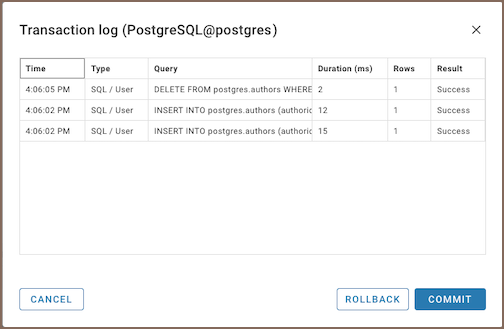Auto and Manual commit modes
Overview
By default, the SQL Editor uses Auto-commit mode, automatically saving changes after each SQL statement. Switch to Manual commit for more control over transactions.
Manual commit mode
In Manual commit mode, you can commit or rollback transactions manually. Use it for multiple queries or to review changes before saving.
| Action | Icon | Description |
|---|---|---|
| Switch to manual commit | Enables manual transaction control. You must Commit or Rollback changes manually. | |
| Commit | Saves changes to the database. | |
| Rollback | Reverts changes in the current transaction. | |
| Switch to auto-commit | Restores Auto-commit mode, where changes are saved automatically. | |
| Transaction log | Opens the Transaction Log. |
After committing in Manual commit mode, click Refresh to update the Result tab.
Transaction log
The Transaction Log shows all transactions (queries of the transaction type, such as INSERT, DELETE, UPDATE,
and others) made during the current Team Edition session. To open the Transaction Log, click Open transaction
log in the toolbar.
The Open transaction log button also displays the number of uncommitted queries.

In the Transaction log window, you can interact with the following fields:
| Field | Description |
|---|---|
| Time | Shows when the query was executed. |
| Type | Identifies the type of query (e.g., SQL/User). |
| Query | Lists all uncommitted queries. |
| Duration | Displays how long each query took to execute. |
| Rows | Indicates how many rows each query affected. |
| Result | Shows the query status. |
Tip: Double-click a Query field to view the full query.
Limitations of Rollback capabilities
In database management, not all commands support rollback operations. It is crucial to understand that Data Definition
Language (DDL) commands—such as CREATE, DROP, or ALTER cannot be reversed with transactions for some databases.
This means that once these commands are executed, they cannot be reversed even in manual commit mode.
Important: Always check the transaction support for the specific database you are working with to avoid irreversible operations.
